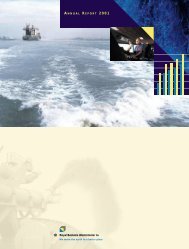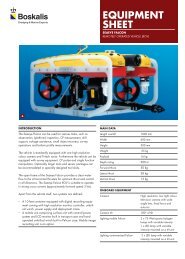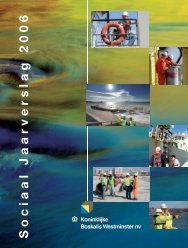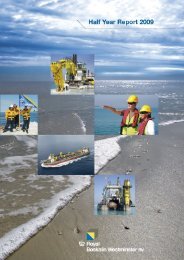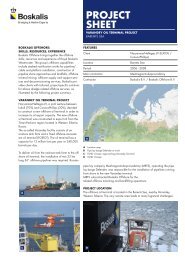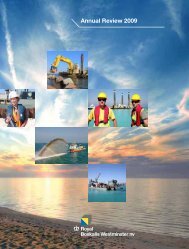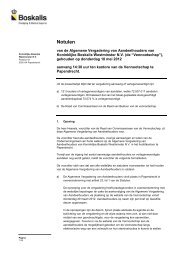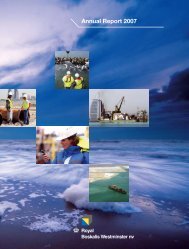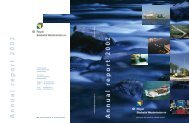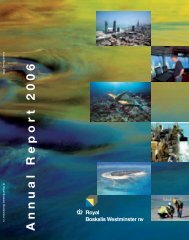Annual report 20108.31 MB - Boskalis
Annual report 20108.31 MB - Boskalis
Annual report 20108.31 MB - Boskalis
- No tags were found...
Create successful ePaper yourself
Turn your PDF publications into a flip-book with our unique Google optimized e-Paper software.
Financial statements 2010translation reserve in group equity. Exchange ratedifferences as a result of operational transactionsare included in the consolidated income statementof the <strong>report</strong>ing period. The foreign currency gainor loss on monetary items is the difference betweenamortized cost in the functional currency at thebeginning of the year, adjusted for effective interestand payments during the year, and the amortizedcost in foreign currency translated at the exchangerate at the end of the year. Non-monetary items thatare measured in terms of historical cost in a foreigncurrency are translated using the exchange rate atthe date of the transaction.3.4 Derivatives and hedgingIt is the policy of Royal <strong>Boskalis</strong> Westminster N.V.to use cash flow hedges to cover all operationalcurrency risks that mainly relate to future cash flowsfrom contracts that are highly probable and that aredenominated in currencies other than the relevantfunctional currency. Fuel price risks and interestrate risks in future cash flows can be hedged fromtime to time using specific derivatives.Hedge accounting is applied to the majority ofcash flow hedges as follows. On initial designationof the hedge, the Group formally documents therelationship between the hedging instrument(s)and hedged item(s), including the risk managementobjectives and strategy in undertaking the hedgetransaction, together with the methods that will beused to assess the effectiveness of the hedgingrelationship. The Group makes an assessment,both at the inception of the hedge relationship aswell as on an ongoing basis, whether the hedginginstruments are expected to be “effective” inoffsetting the changes in the fair value or cash flowsof the respective hedged items during the periodfor which the hedge is designated, and whether theactual results of each hedge are within a range of80-125 percent. For a cash flow hedge of a forecasttransaction, the transaction should be highlyprobable to occur and should present an exposureto variations in cash flows that could ultimatelyaffect <strong>report</strong>ed net income.The application of hedge accounting means thatmovements in the market value of cash flow hedgesnot yet settled – including results realized on the“rolling forward” of existing hedges as a result ofdifferences between the duration of the hedgesconcerned and the underlying cash flows – will bedirectly added or charged to the hedging reservein group equity, taking taxation into account. If acash flow hedge added or charged to the groupequity either expires, is closed or is settled, or thehedge relation with the underlying cash flows canno longer be considered effective, the accumulatedresult will continue to be recognized in groupequity as long as the underlying cash flow is stillexpected to take place. When the underlyingcash flow actually takes place, the accumulatedresult is included directly in the income statement.Movements in the market value of cash flowhedges to which no hedge accounting is applied(ineffective cash flow hedges and the ineffectiveportion of effective cash flow hedges) are includedin the income statement for the <strong>report</strong>ing period.Results from settled effective cash flow hedges andthe movements in the market value of ineffectivecash flow hedges are recognized in the relateditems within the operating result. The purchase orsale of financial instruments is generally recordedat transaction rate. Derivatives are stated at fairvalue; attributable transaction costs are recognizedin profit or loss as incurred. Subsequent to initialrecognition, derivatives are measured at fairvalue, and changes therein are accounted for asdescribed.3.5 ImpairmentThe book value of the assets of the Group,excluding inventories, assets arising from employeebenefits and deferred income tax assets is reviewedat each balance sheet date to determine whetherthere is any indication of impairment. If any suchindication exists, an estimate of the realizableamount of the asset is made. For goodwill, assetswith an indefinite useful life and intangible assetsnot yet ready for use, the realizable amountis estimated annually. An impairment loss isrecognized when the book value of an asset or itscash-generating unit to which it belongs exceeds itsrealizable amount.Royal <strong>Boskalis</strong> Westminster nv77



